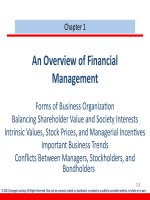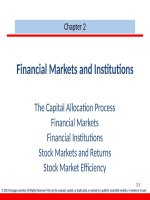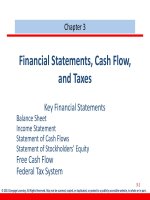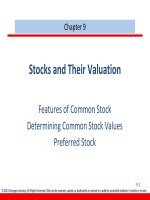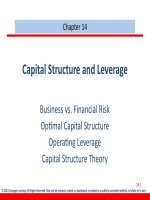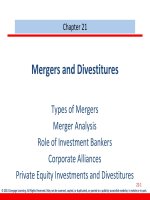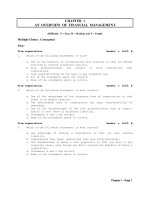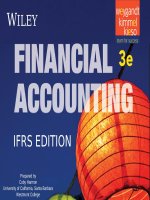Fundamental of financial management 13th ed brigham houston chapter 02
Bạn đang xem bản rút gọn của tài liệu. Xem và tải ngay bản đầy đủ của tài liệu tại đây (114.16 KB, 16 trang )
Chapter 2
Financial Markets and Institutions
The Capital Allocation Process
Financial Markets
Financial Institutions
Stock Markets and Returns
Stock Market Efficiency
2-1
© 2013 Cengage Learning. All Rights Reserved. May not be scanned, copied, or duplicated, or posted to a publicly accessible website, in whole or in part.
The Capital Allocation Process
•
In a well-functioning economy, capital flows
efficiently from those who supply capital to those
who demand it.
•
Suppliers of capital: individuals and institutions
with “excess funds.” These groups are saving
money and looking for a rate of return on their
investment.
•
Demanders or users of capital: individuals and
institutions who need to raise funds to finance their
investment opportunities. These groups are willing
to pay a rate of return on the capital they borrow.
2-2
© 2013 Cengage Learning. All Rights Reserved. May not be scanned, copied, or duplicated, or posted to a publicly accessible website, in whole or in part.
How is capital transferred between savers and
borrowers?
•
•
•
Direct transfers
Investment banks
Financial intermediaries
2-3
© 2013 Cengage Learning. All Rights Reserved. May not be scanned, copied, or duplicated, or posted to a publicly accessible website, in whole or in part.
What is a market?
•
A market is a venue where goods and services are
exchanged.
•
A financial market is a place where individuals and
organizations wanting to borrow funds are brought
together with those having a surplus of funds.
2-4
© 2013 Cengage Learning. All Rights Reserved. May not be scanned, copied, or duplicated, or posted to a publicly accessible website, in whole or in part.
Types of Financial Markets
•
•
•
•
•
Physical assets vs. Financial assets
Spot vs. Futures
Money vs. Capital
Primary vs. Secondary
Public vs. Private
2-5
© 2013 Cengage Learning. All Rights Reserved. May not be scanned, copied, or duplicated, or posted to a publicly accessible website, in whole or in part.
The Importance of Financial Markets
•
Well-functioning financial markets facilitate the
flow of capital from investors to the users of
capital.
– Markets provide savers with returns on their money
•
•
saved/invested, which provide them money in the
future.
– Markets provide users of capital with the necessary
funds to finance their investment projects.
Well-functioning markets promote economic
growth.
Economies with well-developed markets perform
better than economies with poorly-functioning
markets.
2-6
© 2013 Cengage Learning. All Rights Reserved. May not be scanned, copied, or duplicated, or posted to a publicly accessible website, in whole or in part.
What are derivatives? How can they be used to
reduce or increase risk?
•
•
•
A derivative security’s value is “derived” from the
price of another security (e.g., options and futures).
Can be used to “hedge” or reduce risk. For
example, an importer, whose profit falls when the
dollar loses value, could purchase currency futures
that do well when the dollar weakens.
Also, speculators can use derivatives to bet on the
direction of future stock prices, interest rates,
exchange rates, and commodity prices. In many
cases, these transactions produce high returns if
you guess right, but large losses if you guess wrong.
Here, derivatives can increase risk.
2-7
© 2013 Cengage Learning. All Rights Reserved. May not be scanned, copied, or duplicated, or posted to a publicly accessible website, in whole or in part.
Types of Financial Institutions
•
•
•
•
•
•
•
•
•
•
Investment banks
Commercial banks
Financial services corporations
Credit unions
Pension funds
Life insurance companies
Mutual funds
Exchange traded funds
Hedge funds
Private equity companies
2-8
© 2013 Cengage Learning. All Rights Reserved. May not be scanned, copied, or duplicated, or posted to a publicly accessible website, in whole or in part.
Physical Location Stock Exchanges vs. Electronic
Dealer-Based Markets
•
Auction market vs. Dealer market (Exchanges vs.
OTC)
•
•
NYSE vs. Nasdaq
Differences are narrowing
2-9
© 2013 Cengage Learning. All Rights Reserved. May not be scanned, copied, or duplicated, or posted to a publicly accessible website, in whole or in part.
Stock Market Transactions
•
Apple Computer decides to issue additional stock
with the assistance of its investment banker. An
investor purchases some of the newly issued
shares. Is this a primary market transaction or a
secondary market transaction?
– Since new shares of stock are being issued, this is a
•
primary market transaction.
What if instead an investor buys existing shares of
Apple stock in the open market. Is this a primary or
secondary market transaction?
– Since no new shares are created, this is a secondary
market transaction.
2-10
© 2013 Cengage Learning. All Rights Reserved. May not be scanned, copied, or duplicated, or posted to a publicly accessible website, in whole or in part.
What is an IPO?
•
An initial public offering (IPO) occurs when a
company issues stock in the public market for the
first time.
•
“Going public” enables a company’s owners to raise
capital from a wide variety of outside investors.
Once issued, the stock trades in the secondary
market.
•
Public companies are subject to additional
regulations and reporting requirements.
2-11
© 2013 Cengage Learning. All Rights Reserved. May not be scanned, copied, or duplicated, or posted to a publicly accessible website, in whole or in part.
S&P 500 Index, Total Returns: Dividend Yield +
Capital Gain or Loss, 1968-2010
2-12
© 2013 Cengage Learning. All Rights Reserved. May not be scanned, copied, or duplicated, or posted to a publicly accessible website, in whole or in part.
Where can you find a stock quote, and what does
one look like?
•
Stock quotes can be found in a variety of print sources
(The Wall Street Journal or the local newspaper) and
online sources (Yahoo!Finance, CNNMoney, or MSN
MoneyCentral).
Stock Quote for GlaxoSmithKline, July 11, 2011
Source: GlaxoSmithKline (GSK), finance.yahoo.com.
2-13
© 2013 Cengage Learning. All Rights Reserved. May not be scanned, copied, or duplicated, or posted to a publicly accessible website, in whole or in part.
What is meant by stock market efficiency?
•
Securities are normally in equilibrium and are
“fairly priced.”
•
Investors cannot “beat the market” except through
good luck or better information.
•
Efficiency continuum
Highly
Inefficient
Highly
Efficient
Small companies not followed by
many analysts. Not much contact
with investors.
Large companies followed by
many analysts. Good
communications with investors.
2-14
© 2013 Cengage Learning. All Rights Reserved. May not be scanned, copied, or duplicated, or posted to a publicly accessible website, in whole or in part.
Implications of Market Efficiency
•
You hear in the news that a medical research
company received FDA approval for one of its
products. If the market is highly efficient, can you
expect to take advantage of this information by
purchasing the stock?
– No.
If the market is efficient, this information will
already have been incorporated into the company’s
stock price. So, it’s probably too late for her to
“capitalize” on the information.
2-15
© 2013 Cengage Learning. All Rights Reserved. May not be scanned, copied, or duplicated, or posted to a publicly accessible website, in whole or in part.
Implications of Market Efficiency
•
A small investor has been reading about a “hot” IPO
that is scheduled to go public later this week. She
wants to buy as many shares as she can get her
hands on, and is planning on buying a lot of shares
the first day once the stock begins trading. Would
you advise her to do this?
– Probably not.
The long-run track record of hot IPOs
is not that great, unless you are able to get in on the
ground floor and receive an allocation of shares
before the stock begins trading. It is usually hard for
small investors to receive shares of hot IPOs before
the stock begins trading.
2-16
© 2013 Cengage Learning. All Rights Reserved. May not be scanned, copied, or duplicated, or posted to a publicly accessible website, in whole or in part.


